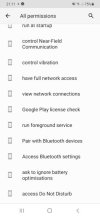Hello there
I'm looking at getting xdrip+ working in my Galaxy A40, following the instructions in here https://xdrip.readthedocs.io/en/latest/install/libre2/#manually-changing-settings
The way I read it is that I need to uninstall LibreLink before I connect the sensor to xdrip. I would like to still be able to run LibreLink so that the data is uploaded to Libreview. Does anyone have any experience of running LibreLink an xdrip in parallel?
I'm looking at getting xdrip+ working in my Galaxy A40, following the instructions in here https://xdrip.readthedocs.io/en/latest/install/libre2/#manually-changing-settings
The way I read it is that I need to uninstall LibreLink before I connect the sensor to xdrip. I would like to still be able to run LibreLink so that the data is uploaded to Libreview. Does anyone have any experience of running LibreLink an xdrip in parallel?

